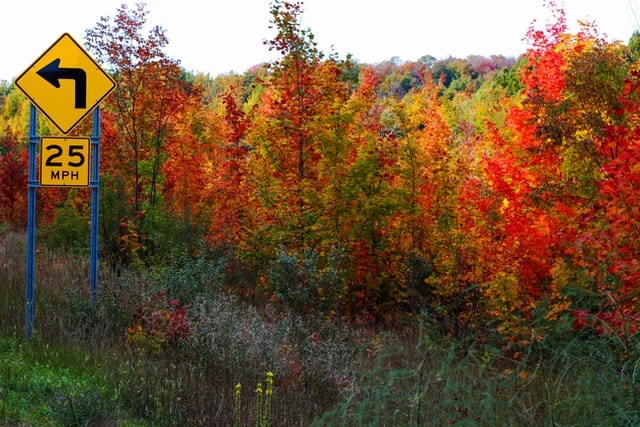According to the Federal Highway Administration, Regulatory Signs are defined as “signs that give orders. They tell road users what they must or must not do under certain conditions.”
These signs play a pivotal role in highway and neighborhood speed limits.
Contents
How Are Neighborhood Speed Limits Set?
Local jurisdictions set neighborhood speed limits, which are typically lower than the posted speed limit on the surrounding roadways.

The purpose of these speed limits is to promote safety in areas with more pedestrians, cyclists, and other non-motorized traffic.
Regulatory Signs
There are a few different types of Regulatory Signs commonly used to enforce speed limits in neighborhoods.
Such signage can include Stop Signs, Fines Higher, Residential Signs, Begin Signs, End SignsLimit Signs, and No Parking Signs.
You will notice Regulatory signs by their rectangular shape and white backgrounds with black or red letters or symbols.
These signs help maintain traffic control because they keep order on the roadways and ensure the safety of all drivers, passengers, and pedestrians.
Stop Signs
Stop signs, for example, are used to control traffic flow and give drivers a clear indication of when they must stop. When entering a neighborhood with a posted speed limit, drivers should be prepared to stop at any stop sign they encounter.
Yield Signs
Yield signs notify drivers of oncoming traffic or pedestrians. They indicate when a driver should yield the right-of-way. When it comes to neighborhood speed limits, drivers should use caution when approaching yield signs and be prepared to yield to oncoming traffic or pedestrians.
Speed Limit Signs
Speed limit signs are posted to remind drivers of the maximum speed limit for a particular area. Neighborhood speed limits are typically lower than the posted speed limit on the surrounding roadways, so drivers should be prepared to slow down when entering a neighborhood.
No Parking
No parking signs are used to prohibit parking in certain areas, such as fire lanes or handicapped parking spaces. Some neighborhoods may post no parking signs to prohibit parking on certain streets or certain areas like school zones or local parks.
Fines Higher
Fines Higher signs are posted in areas where the penalties for speeding or other traffic violations are more severe.
In some neighborhoods, these signs serve to remind drivers that the fines for speeding or other traffic violations are higher than in the surrounding area. Sometimes the fees are double, especially in school zones.
Tips for Driving in Neighborhoods
Now that you know a little bit more about Regulatory Signs and neighborhood speed limits, here are a few tips for driving in neighborhoods:
Obey all Regulatory Signs
Regulatory signs are in place for a reason, so it’s important to obey them. Failure to respect a regulatory sign can result in a traffic citation.
Slow Down
The posted speed limit in a neighborhood is the maximum speed you should be driving. However, you may need to drive even slower than the posted speed limit if there are pedestrians or other non-motorized traffic.
Your pedestrians may include little children and the elderly who are not as agile as you.
Many neighborhoods also have bike lanes now. So, pay attention and be prepared to share the road with cyclists.
Be Courteous
When driving in a neighborhood, be courteous to your fellow drivers, pedestrians, and cyclists. This courtesy means yielding the right-of-way when appropriate, not honking your horn unnecessarily, and not speeding.
Use Caution
When driving in a neighborhood, always use caution. Be prepared to stop for pedestrians or oncoming traffic and be aware of your surroundings.
Respect the Residents
Remember that neighborhoods are someone’s home. Drive courteously and be respectful of the residents who live there.
Respect Rules Even If You Don’t See Signs
Just because you don’t see a Regulatory Sign doesn’t mean the rules don’t apply. Speed limits and other traffic regulations are still in effect, even if you don’t see a sign.
By following these tips, you can help to keep the neighborhood safe for everyone.
Can Neighborhood Speed Limits Change?
The posted speed limit in a neighborhood can change for a variety of reasons, such as construction or new development.
If you are unsure of the posted speed limit in a particular area, it is always best to err on the side of caution and drive at a safe speed. An ideal safe speed is about five to ten miles per hour below the posted limit.
Observing Neighborhood Speed Limits Are for Everyone’s Safety
Neighborhood speed limits are set by local jurisdictions and are typically lower than the posted speed limit on the surrounding roadways. Regulatory signs, such as stop signs, yield signs, and speed limit signs, are posted to remind drivers of the maximum speed limit for a particular area.
Make sure you use professional services to produce your regulatory signage. You want a sign that is visible, sturdy, and up to date on the latest traffic rules.
When driving in a neighborhood, always use caution and be prepared to stop for pedestrians or oncoming traffic. Remember that neighborhoods are someone’s home.






![DNS_Probe_Finished_No_Internet Error [RESOLVED] Fix DNS_Probe_Finished_No_Internet Error](https://howandwow.info/wp-content/uploads/2019/09/Fix-DNS_Probe_Finished_No_Internet-Error.jpg)
![Err_Connection_Reset Error in Chrome [RESOLVED] Fix Err_Connection_Reset Error in Google Chrome](https://howandwow.info/wp-content/uploads/2019/09/Fix-Err_Connection_Reset-Error-in-Google-Chrome.jpg)
![Err_Cache_Miss in Google Chrome Error [RESOLVED] Err_Cache_Miss in Google Chrome Error](https://howandwow.info/wp-content/uploads/2019/08/How-to-Fix-Confirm-Form-Resubmission-Error.jpg)





![Steam Missing File Privileges Error [RESOLVED] How to Fix Steam Missing File Privileges](https://howandwow.info/wp-content/uploads/2020/07/How-to-Fix-Steam-Missing-File-Privileges-Error-100x70.jpg)





![SIM Not Provisioned MM#2 Error [RESOLVED] SIM Not Provisioned MM#2](https://howandwow.info/wp-content/uploads/2020/03/SIM-Not-Provisioned-MM2.jpg)







